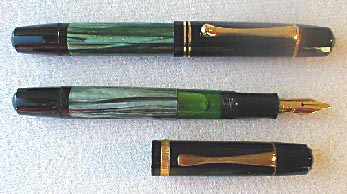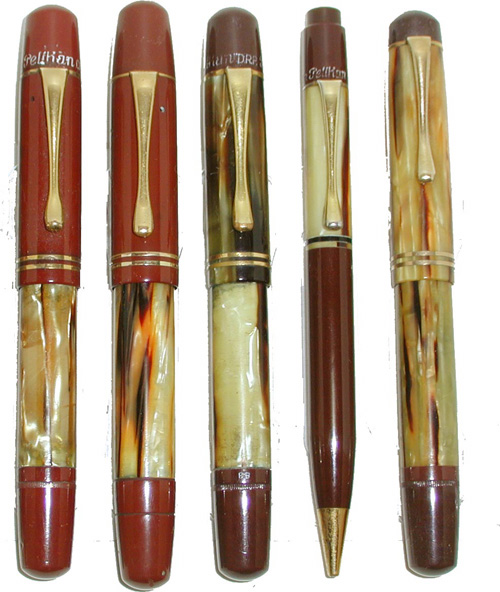| At the eve of World War II, Pelikan pens were sold all over the world,
including Europe, India and throughout South America, but were manufactured in
at least one site outside the country. The history of foreign manufacture of Pelikans
is obscure and something we hope to address later this series, but we do know
just a bit about it. Pelikan was certainly not the only company to sell beyond
their borders in the 1920s and 1930s. Montblanc, Parker and Waterman all distributed
and manufactured beyond their countries of origin and Pelikan was well poised
to follow suit as they were long since established as makers and purveyors of
office and art supplies. Beyond that the story becomes a bit obscure.
There was one well-documented production facility in Danzig. More than any
other foreign plant, the products of the Langfuhr factory differed from the Hannover
products most notably in the distinctive diamond shaped clip and the appearance
during the war of the single cap band. Nibs may have been made there, some of
them bearing a distinctive round “P” logo.
Beyond Danzig, the record becomes far less clear. We know that Pelikan had
plants in Bucharest, Barcelona, Milan, Sofia, Vienna, Warsaw, Zagreb, Zürich,
and throughout South America, but mainly they produced ink and office supplies.
However, in every branch there were pen repair facilities that had spare parts
and out of those parts pens may have been assembled. According to Jürgen
Dittmer, that is the basis of the belief that Pelikan pens were produced in Zagreb
and elsewhere.
Then there are the so-called Emegê pens, stamped with the name of Pelikan’s
Portugal distributor. By one account, the Portugese Pelikan distributor, Leichsenring,
had an unusually lenient repair policy and found themselves fixing pens that they
had not sold, so they began “branding” their pens. But they may also
have sold exclusively one model, the “Magnum” oversize 100N. Many
of these show up with the Emegê stamp, indicating that they came out of
Portugal. Where they were produced is another matter, whether Germany or possibly
the postwar Milan plant. Looking at the pens produced in these locations, Danzig,
Milan, Portugal, Zagreb, suggests that at least some parts were locally produced.
World War II, of course, had an impact on Pelikan. However, they were able
to manufacture until the last year of the war when they closed down, it is not
clear whether by edict or because of material shortages. However, the rule of
the Nazis had its impact even before the war. As early as 1938 the German government
began limiting the use of gold and forcing export trade for the purpose of securing
hard currency. By 1938, many of Pelikan’s luxury models could be sold only
outside the country and in Germany pens could be sold only with steel alloy nibs.
When Pelikan resumed production after the war, they initially continued producing
their prewar models, minus the 100. The same was true, by the way, all over the
world. The 1946 Ford, for example, is identical to the 1942 model, which in the
U.S. was the last prewar car made by that firm.
There were, however, postwar changes, mostly in materials. Gold for nibs was
again available, and many of the wartime Pd and CN nibs were swapped out for postwar
14 karat nibs. These nibs, which may also have been made before the war for export
models, resembled the traditional nibs, except that the imprint bore the word
Pelikan in a plain rather than incised script. Also the successor to the cork
seal, which was first replaced by rubber during the war, was now perfected. The
new seals were made now of a clear elastomer. Finally, the 100N lost the ridge
that connected the hard rubber section to the celluloid barrel on the early models
and was now manufactured with a smooth, one piece celluloid shaft just as the
later 100s had been.

Two common variants of the Pelikan 100N,
with two narrow cap bands and regular drop clip and with fluted cap band and clip.
From the collection of Gerhard Brandl, photography by Gerhard Brandl.

A variant of the Pelikan 100N was made
without a clip to go smoothly into women’s purses. These pens did not have
the common ribbon ring often found on women’s pens. From the collection
of Gerhard Brandl, photography by Gerhard Brandl.

100Ns in tortoise, left to right 100N
tortoise and red hard rubber, uncommon 100N Magnum (oversize), 101N pen and pencil
in celluloid, short captop late 101N. From the collection of Rick Propas. Photography
by Rick Propas
Foreign production was also resumed, this time only in Milan and using old
equipment for the manufacture of hard rubber pens imported presumably from Hannover.
Over the next few years, Milan produced not just pre-war pens, but a number of
variants. Some of the most interesting of these pens were 100N pocket and desk
pens made without a binde. The colored celluloid was integral to the barrel and
not an overlaid band as had been the case with virtually every Pelikan made up
to that time. The nibs and clips were also unique to the facility. Production
in Milan did not last long, however, due to quality issues. Today, the immediate
postwar Milan pens are highly valued by many of the more compulsive Pelikan collectors.
The postwar European economic miracle would take Pelikan to new heights. As
early as 1950 a new model, the 400, was introduced, as part of the most thoroughgoing
product redesign in the company’s history At the same time, though, Pelikan
hedged their bets on both prosperity and postwar modernism by introducing the
120, 140 and 300, lower cost lines based on the familiar shapes of the Rap-pen
and the Ibis. But the firm’s postwar fortune and the design idiom that marks
the top line Pelikans to this day would come with the 400.

Pelikan 400s in green and tortoise.
From the collection of Gerhard Brandl, photography by Gerhard Brandl.
Despite it’s new appearance, at its heart the 400 was very much a Pelikan,
featuring the same basic design as the 100. As before the body of the pen was
made up by a shaft covered by a binde, now striped rather than marbled. The cap
was somewhat changed, now in four parts with a tube, captop and beaked clip held
to the captop by a washer, and, of course, the signature piston filler, now redesigned
and made entirely out of plastic. In fact, take apart some of the early tortoise
400s, and you will even find a yellow celluloid shaft, just like the earliest
100s. In automotive circles, Porsche is reknowned for its conservative, yet stylish,
design tradition, the basic shape of the cars dating back to 1965. Today the so-called
Souverän Pelikans, the 300-1000 series, carry on a design originated even
earlier, 53 years ago.
Note: Any history of Pelikan must rely on
two basic accounts, those of Jürgen Dittmer and Martin Lehmann in Pelikan
Schreibgeräte, and Andreas Lambrou, most completely in Fountain Pens of the
World. In addition, I have used Pelikan’s own company history, available
at ChartPak. I also
found helpful material in The PENnant (vol.XV, no.2, Summer 2001) which was devoted
to Pelikan and which I edited. Other material on pen history in general came from
Bowen and Lambrou. There is a small amount of useful Pelikan material in Miroslav
Tischler’s Penkala Writing Instruments. Regina Martini’s Pens &
Pencils, is a good source for identifying models and for background.
I am indebted to Gerhard Brandl, Jurgen Dittmer, Martin Lehmann,
Sharon Propas and Len Provisor who read, commented and fact-checked this history.
I, and not they, however, am responsible for all errors, omissions and bad commas.
Text © 2003 Rick Propas. Photos © 2003 as indicated in
captions.
|